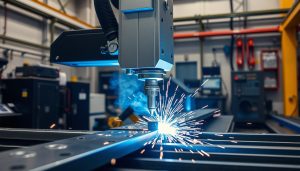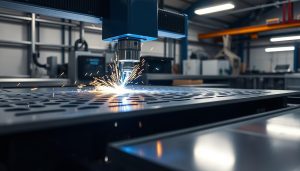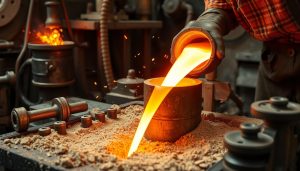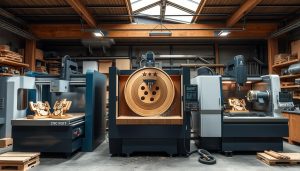In the world of metal fabrication, two primary manufacturing processes stand out: machining and casting. Choosing the right approach can significantly impact the cost, quality, and overall success of your project. This article delves into the nuances of these two methods, exploring their advantages, disadvantages, and the factors to consider when selecting the best fit for your needs.
What is Machining?
Machining is a fundamental subtractive manufacturing process that involves the removal of material from a workpiece to create the desired shape, size, and finish. This precision-driven technique utilizes cutting tools to shave, grind, or drill away portions of the material, transforming raw stock into intricate, high-quality parts.
Overview of the Machining Process
The machining process typically begins with a solid block or sheet of material, such as metal, plastic, or wood. A skilled operator or a computer-controlled machine tool, like a CNC (Computer Numerical Control) machine, then uses a variety of cutting tools to selectively remove material from the workpiece. This material removal process allows for the creation of complex geometries, tight tolerances, and exceptional surface finishes.
Types of Machining Methods: CNC, Milling, Turning, and Drilling
- CNC Machining: Computer Numerical Control (CNC) machining is a highly automated process that utilizes computer-programmed machines to perform a wide range of machining operations with unparalleled precision and repeatability.
- Milling: Milling is a subtractive manufacturing process that uses rotating cutting tools to remove material from a workpiece, enabling the creation of complex shapes, grooves, and contours.
- Turning: Turning is a machining process that involves the use of a lathe to rotate a workpiece against a stationary cutting tool, allowing for the creation of cylindrical or tapered parts.
- Drilling: Drilling is a machining process that uses a rotating tool, known as a drill bit, to create holes of various sizes and shapes in a workpiece, often as a preparatory step for other machining operations.
These versatile machining methods, combined with the latest advancements in technology, enable manufacturers to produce a wide range of high-precision components with exceptional quality and efficiency, making machining a critical component in modern subtractive manufacturing, material removal, and precision cutting processes.
What is Casting?
Casting is a manufacturing process that involves pouring molten metal into a mold and allowing it to solidify. This versatile technique enables the creation of intricate shapes and complex designs that are challenging to achieve through other manufacturing methods. The casting process is renowned for its efficiency in high-volume production, making it a popular choice for a wide range of industries.
Understanding the Casting Process
The casting process typically involves the following steps:
- Mold Preparation: A mold is created using a variety of materials, such as sand, metal, or ceramic, to form the desired shape of the final part.
- Molten Metal Pouring: The molten metal, such as molten metal, is poured into the prepared mold, filling the cavities and negative spaces.
- Mold Filling: The molten metal flows and fills the mold, taking on the shape of the internal cavities.
- Solidification: The metal within the mold is allowed to cool and solidification occurs, resulting in the desired cast part.
- Mold Removal: Once the metal has solidified, the mold is removed, revealing the final cast part.
Types of Casting Methods
There are several different casting methods used in manufacturing, each with its own unique advantages and applications:
- Die Casting: Involves the use of a reusable mold, or die, to produce high-volume, precise parts with a consistent surface finish.
- Sand Casting: Uses a sand mold to create larger, more complex parts with a rougher surface finish, often used for prototypes or low-volume production.
- Investment Casting: Also known as “lost-wax” casting, this method is capable of producing intricate parts with a smooth surface finish, making it ideal for jewelry and medical implants.
Each casting method has its own unique benefits and is suitable for different applications, allowing manufacturers to select the most appropriate technique for their specific project requirements.

Key Differences Between Machining and Casting
When it comes to manufacturing, both machining and casting have their unique advantages and disadvantages. Understanding the key differences between these two methods is crucial in determining the best approach for your project.
Material Waste and Efficiency
Machining is generally more efficient in terms of material utilization. The process involves removing material from a solid block or billet, resulting in minimal waste. In contrast, casting can produce more material waste, as the process involves pouring molten metal into a mold, which may leave behind excess material.
Production Speed and Costs
Casting is often the more cost-effective and faster production method, especially for large-scale manufacturing. The casting process can produce multiple parts simultaneously, while machining typically requires a longer setup time and is better suited for smaller production runs.
Precision and Surface Finish
Machining offers a higher level of precision and surface finish compared to casting. The controlled nature of the machining process allows for tighter tolerances and smoother surfaces, making it the preferred choice for applications that require exceptional part quality and surface finish.
Strength and Durability of Parts
Casting can produce parts with superior strength and durability, as the casting process can result in a more uniform and dense material structure. Machined parts, on the other hand, may have slightly lower strength due to the removal of material during the manufacturing process.
By understanding these key differences, manufacturers can make an informed decision on the best manufacturing method for their specific project requirements, taking into account factors such as manufacturing comparison, process efficiency, and part quality.

Advantages and Disadvantages of Machining
Machining is a highly versatile manufacturing process that offers numerous benefits, particularly when it comes to producing precision parts and custom components. One of the primary advantages of machining is its ability to achieve high precision and tight tolerances, making it an ideal choice for industries that require exacting specifications, such as aerospace, medical, and automotive.
High Precision and Tolerances
Machining techniques, such as CNC (Computer Numerical Control) milling and turning, allow for the creation of parts with exceptional accuracy and repeatability. This precision is crucial for ensuring the proper fit and function of critical components, ultimately enhancing the overall machining benefits and performance of the final product.
Material Waste and Cost Considerations
While machining offers unparalleled precision, it can also result in higher material waste compared to other manufacturing processes like casting. This material waste can contribute to increased production costs, which is an important factor to consider when evaluating the suitability of machining for a particular project. However, advances in software and machine tools have helped to minimize material waste and improve the overall cost-efficiency of the machining process.
Ideal Applications for Machining
- Production of precision parts for aerospace, medical, and automotive industries
- Fabrication of custom components with complex geometries or tight tolerances
- Prototyping and small-to-medium production runs of specialized products
- Manufacturing of high-quality, durable goods that require exceptional surface finishes and mechanical properties
Overall, machining remains a highly valuable manufacturing process, offering unparalleled machining benefits in terms of precision, customization, and quality. By carefully considering the specific requirements of a project and weighing the advantages against the potential drawbacks, manufacturers can make informed decisions on the most suitable production method for their needs.
Advantages and Disadvantages of Casting
When it comes to manufacturing, casting offers several distinct advantages that make it a compelling choice, especially for high-volume production and complex geometries. Let’s delve into the key benefits and considerations of this versatile process.
Cost-Effective for Large Volumes
One of the primary advantages of casting is its inherent cost-effectiveness for producing parts in large quantities. The initial investment in mold creation is offset by the ability to quickly and efficiently manufacture numerous identical components. This makes casting an ideal solution for high-volume production scenarios, where economies of scale come into play.
Surface Finish and Complexity Considerations
Casting techniques also excel in their ability to create parts with intricate complex geometries and smooth surface finishes. The molding process allows for the precise replication of detailed designs, making casting a preferred choice for decorative items, automotive parts, and other applications where aesthetics and visual appeal are important.
Best Uses for Casting in Manufacturing
- Automotive components: Engine blocks, transmission housings, and brake components
- Household appliances: Handles, knobs, and decorative elements
- Industrial equipment: Pump housings, valve bodies, and gear casings
- Architectural features: Ornamental elements, statues, and fountains
While casting offers numerous casting benefits, it’s important to consider the potential limitations, such as the requirement for specialized tooling and the potential for inconsistencies in the final product. As with any manufacturing process, a thorough evaluation of the project’s needs and constraints is essential to determine the most suitable approach.
| Advantages of Casting | Disadvantages of Casting |
|---|---|
| Cost-effective for high-volume production | Specialized tooling required |
| Ability to create complex geometries | Potential for inconsistencies in final product |
| Smooth surface finish | Limited design flexibility compared to machining |
How to Choose Between Machining and Casting
When it comes to your manufacturing project, the choice between machining and casting can significantly impact the final outcome. Several key factors, including production volume, part design complexity, and material selection, play a crucial role in determining the optimal manufacturing process.
Factors to Consider: Volume, Part Design, Material Selection
For projects with low to medium production volumes, machining often offers greater flexibility and precision, allowing for customized parts and intricate designs. However, for high-volume manufacturing, casting may be the more cost-effective solution, enabling faster production rates and reduced material waste.
The complexity of your part design is another essential consideration. Casting is well-suited for parts with complex geometries or intricate features, as the process can easily replicate such details. Conversely, machining excels in producing parts with tighter tolerances and superior surface finishes.
Material selection is also a key factor. Casting allows for a wider range of material options, including metals, plastics, and composites, while machining may be better suited for specialty materials or those with specific physical properties.
Cost vs. Benefit Analysis for Your Project
To make an informed decision, it’s crucial to conduct a thorough cost-benefit analysis of both machining and casting for your specific project requirements. This evaluation should consider factors such as production volume, lead times, tooling costs, and the overall investment required for each manufacturing process.
Shixinproto’s Solutions for Machining and Casting Needs
At Shixinproto, we have the expertise and capabilities to guide you through the decision-making process and provide tailored solutions for your manufacturing needs. Whether you require precision machining or high-volume casting, our team of experts can help you select the most suitable approach and ensure the success of your project.





